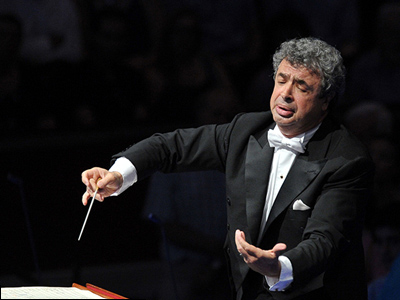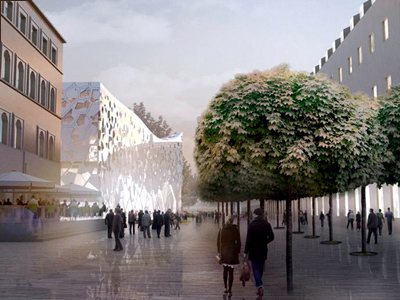
By ANDREW POWELL
Published: June 25, 2015
MUNICH — 2014–15 has been a rough transitional season for the Munich Philharmonic. Lorin Maazel’s sudden resignation a year ago forced its managers into much recasting, and some feeble programs. Then, midseason, came worse news. An irksome pact between Munich’s Bürgermeister Dieter Reiter and Bavaria’s Minister-Präsident Horst Seehofer nixed plans for a needed new concert hall to replace the Gasteig and instead envisioned a joyously slow disemboweling and inner rearrangement of that acoustically poor facility, which would leave the MPhil homeless starting in 2020. The pact sent Anne-Sophie Mutter, Christian Gerhaher and Mariss Jansons into public displays of betrayal, rage and frustration, respectively. But MPhil managers could not whine so loudly because the city owns the orchestra, so, a week behind everyone else, including the testy Bavarian Radio Symphony Orchestra (also affected), they emitted six splendid bureaucratic paragraphs saying absolutely nothing.
Somehow the musicians have ploughed through this temporum horribilis and on Monday (June 22) managed to sound confident and poised at the Gasteig under Semyon Bychkov. Grandly he propelled them in Brahms’s Third Symphony (1883) stressing contrasts and drama with wide arm gestures. Fine wind contributions, not least from principal horn Jörg Brückner, flattered the score’s textures, and Bychkov took a pleasingly weighty and leisurely approach to the middle movements, observing dynamic markings with care. Ravel’s G-Major Piano Concerto (1931) after the break found everyone on less sure footing, however, despite this being the program’s third iteration. Jean-Yves Thibaudet gave a dull, woolly account of the solo part. Ensemble weakened. The long concert remained in French mode for its conclusion, Debussy’s La Mer (1905), but this listener had to run.
Tomorrow, the same partnership performs in the Pala de Andrè as a guest of the Ravenna Festival. MPhil 2014–15 closes fully with concerts here led by Kent Nagano and Krzysztof Urbański, but in September more headaches loom when Valery Gergiev takes over as Chefdirigent. Systems are supposedly in place to prevent the skimpiness of preparation associated with the new boss. It is unclear what, if any, measures are in place to cope with the political challenge.
Photo © Chris Christodoulou
Related posts:
Trifonov’s Rach 3 Cocktail
Stravinsky On Autopilot
On Wenlock Edge with MPhil
Mastersingers’ Depression
Modern Treats, and Andsnes

Concert Hall Design Chosen
Friday, October 27th, 2017By ANDREW POWELL
Published: October 27, 2017
MUNICH — Though it will be built on the wrong side of the wrong train station, Munich’s much-debated, much-delayed new concert hall crept toward reality today with the announcement of a winning design. Bregenz-based Cukrowicz Nachbaur Architekten secured first place in the competition for the venue, now dubbed “Münchner Konzerthaus” (instead of “Konzertsaal München” or “Neues Odeon”), said Bavaria’s Interior Ministry. A 25-person jury reviewed thirty-odd designs yesterday and this morning at the Hochschule für Musik und Theater before reaching its decision. Details will be given tomorrow at a news conference; seating capacity may be stated as 1,800 with project cost at €300 million.
All being well, which is saying a lot in this city on this subject, a bulbous glassy prism with its top planed off will as early as 2019 start to rise just east of Munich East train station on blighted land long home to a Knödel factory. In it symphonic music will be played to audiences larger than at the Herkulessaal and with better acoustics than at the Gasteig, Munich’s two problematic existing halls. The Bavarian Radio Symphony Orchestra will for the first time in its seven-decade history have a home.
But things going smoothly won’t change the location. Questions that have been asked since the site was announced two years ago — out of the blue, in a political about-face after it seemed the whole new-hall idea had been killed by Bürgermeister Dieter Reiter and Bavaria’s Minister-Präsident Horst Seehofer, and following twenty years of consideration of some half-dozen other sites — are stark and tinged with disbelief that a prime location was not feasible. Will people want to travel outside Munich’s historic core for art music? Will concertgoers coming into town from the suburbs want to change trains at Munich Central Station, ride five stops to Munich East, another hub, and then walk 200 meters further east? One would think not. The very benefit of siting the new hall in this drab place, that it could be built expeditiously, may limit its success.
Illustrations © Hans-Joachim Wuthenow
Related posts:
MPhil Bosses Want Continuity
New Hall for Munich?
Chung to Conduct for Trump
Nézet-Séguin: Hit, Miss
Bretz’s Dutchman, Alas Miked
Tags:Bavarian Radio Symphony Orchestra, Commentary, Cukrowicz Nachbaur Architekten, Dieter Reiter, Gasteig, Herkulessaal, Horst Seehofer, Konzertsaal München, München, Münchner Konzerthaus, Munich, Neues Odeon, News, Symphonie-Orchester des Bayerischen Rundfunks
Posted in Munich Times | Comments Closed